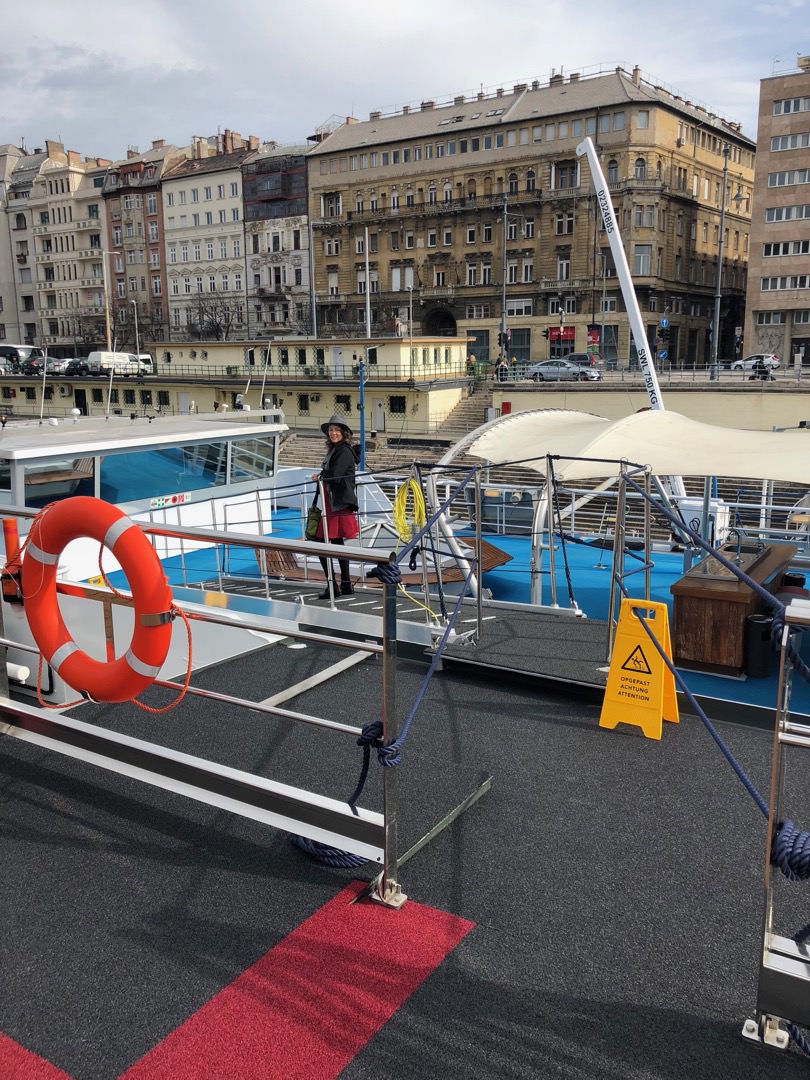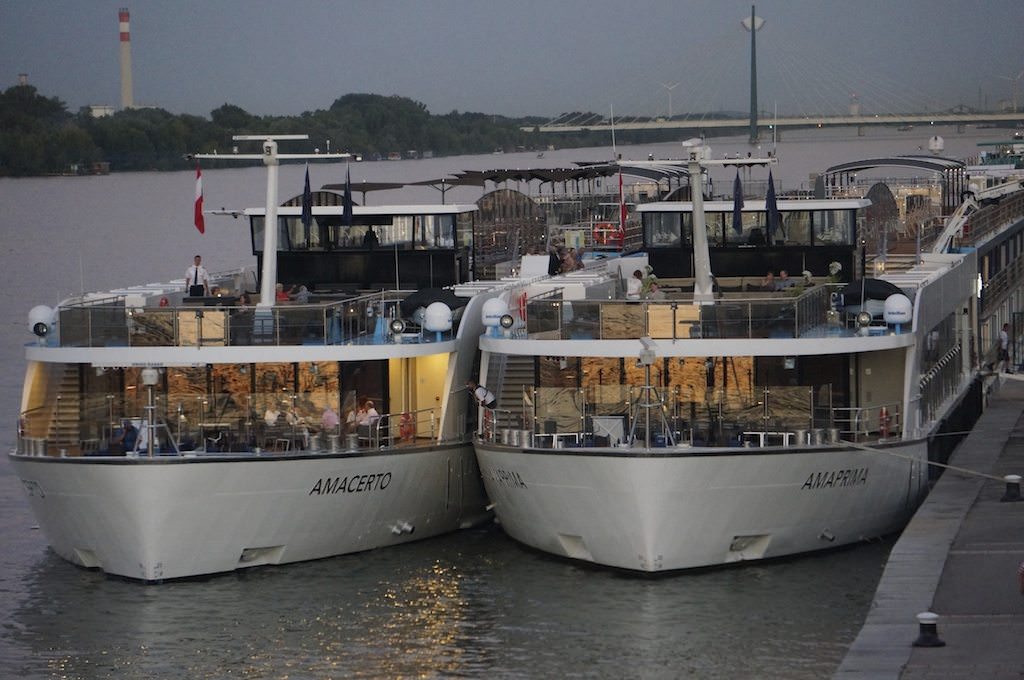
In Budapest this past spring, Riviera’s Robert Burns had to tie up alongside another ship, so that going ashore required ascending a set of stairs, crossing the top deck of the ship beside ours, descending a set of stairs, then walking the gangway to the riverside landing, where the real work began. In the photo you can see a series of concrete stairs that we had to ascend to get to the motorcoach for our tour of Budapest. Of course, such docking situations are the exception rather than the rule, but those who are mobility challenged should be aware that getting on and off the ship won’t always be easy. – © 2018 Ralph Grizzle
Unfortunately, not everyone is able to take a river cruise in Europe. I’m thinking mainly of those with mobility issues who write to me on a weekly basis. It breaks my heart to tell them that river cruising may not be the best choice for them. Why not? First, there’s the infrastructure in Europe itself. Sharp curbs and cobblestoned streets in many destinations can be rough going for those who rely on walkers and wheelchairs or scooters.
While scooters are technically allowed on most river cruisers, they are not recommended and are discouraged as these passengers will find it difficult (if not impossible) to embark/disembark the ships, get on and off the buses, and navigate the cobblestone roads.
For guests coming from North America, this might seem to be unfathomable. The simple fact remains, though, that many cities may not have wheelchair ramps at convenient locations simply due to the structure of the cities themselves, which can be hundreds of years old. While major cities will likely have facilities catering to those confined to a wheelchair, smaller towns and villages are less likely.

Even if your ship happens to be wheelchair-friendly, Europe may not be. Photo © 2015 Aaron Saunders
Variances in water levels along the rivers can result in steep gangways, and some docking locations are downright unfriendly when it comes to the mobility-impaired. Complicating the issue is that sometimes ships have to berth next to one another in some of the more popular destinations. That means getting off the ship to go into town—and getting back on the ship—sometimes requires climbing stairs to get to the sundeck of one ship, then back down the stairs to get to the lower level, through the lobby of another ship, etc. The photo that leads this post shows our ship, Riviera’s Robert Burns, docked in Budapest.

AmaPrima and AmaCerto side by side. When ships operated by the same company are docked together, you can almost always walk through the lobby of one to get to the other. Not always the case when ships from different companies are docked side by side. © 2013 Ralph Grizzle
To spare you from having to climb too many stairs onboard, nearly all of the modern river cruise ships do have elevators, but these do not always travel to every deck, and not all ships have accessible staterooms.
Whether you can take a river cruise or not will ultimately depend on your level of mobility: If you are confined to a wheelchair and cannot leave it for any reason, river cruising likely will not work for you, and we would not recommend it. However, if you are able to stand for short periods of time – in order to perhaps climb stairs on a motorcoach – then it puts river cruising within the realm of possibility.
All of that said, I have seen people in wheelchairs touring Europe by river cruise. They usually have good family support and someone, like me and many others, willing to lend a helping pair of hands. Before making any booking, though, contact the line you’re thinking of and reconfirm whether the line can accommodate wheelchairs in some fashion. While wheelchairs certainly won’t fit through the cabin doors, if one can collapse and the guest can make it into the room with the assistance of a companion, river cruising is possible.
AmaWaterways rents collapsible wheelchairs for $70 (for the duration of the cruise). Motorized scooters, which can help in navigating the cobblestone streets, also can be rented for $140. Other companies have similar policies.
If you’re unable to river cruise because of mobility challenges, an overland journey or a cruise aboard a larger cruise ship would likely be a better choice. See our sister site, Avid Cruiser for ocean-cruise reviews.

I have to use a walker.
Paul…..a Rollator is a walker but with wheels. Look on the internet and you will find many kinds. The one I use is the brand Nitro. This is a bit more expensive but the brake connections are all enclosed in metal which in the long run can save dollars in replacing other types which catch etc. and damage easier. Do travel…and enjoy every minute.
April 16, 2021 at 1:53 pm
Paul…..a Rollator is a walker but with wheels. Look on the internet and you will find many kinds. The one I use is the brand Nitro. This is a bit more expensive but the brake connections are all enclosed in metal which in the long run can save dollars in replacing other types which catch etc. and damage easier. Do travel…and enjoy every minute.
Ralph….loved the barge cruise with you. I am still traveling. Pam and I are planning a Viking river cruise to proceed with our Bavarian tour in May 2022 which includes Oberammergau. The tour was canceled in 2020 and Germany will do it in 2022. Had a Russian river cruise booked for September but that has been canceled. I wrote regarding your mobility posting and thought I would let you know I refer your newsletter and great information whenever someone talks about cruising. Keep up the good work and the world of cruising.
(Note: at 90 in 2022 I expect to be fine.)
I travel with my daughter, a cane, and a rollator which has larger front wheels for moving over rough areas this also provides a seat if a guide is talking at length. With the rollator I did a 4 1/2 hour walking tour in Prague. On his tour, there was one flight of stairs where my daughter collapsed and carried the rollator down (note: several people just asked if they could do it). With the cane, I do stairs up or down and only find it a problem when there is no rail or wall which is an exception. I did not hold up the tour group in Prague or any other port touring. The rollator checks as medical equipment and aboard is in the reception area and on a tour bus placed in the luggage area by the driver. Note: I do tip him each time for this service. I do believe anyone who is using the things I mention or other devices should have a travel companion but should be quite independent allowing that person freedom to also be independent so both can enjoy travel. Know your limitations and be realistic.